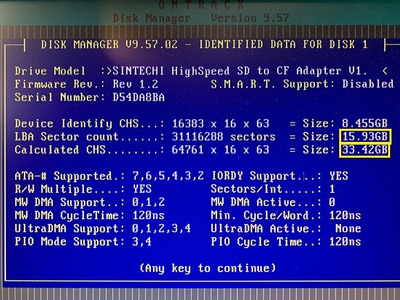First post, by jaZz_KCS
- Rank
- Oldbie
Since I am mainly fiddling around with laptops of the atitlementioned variety, I thought that this short experience report might come in handy for ppl seeking advice in regards to these kinds of adapters, so please excuse my rant. What follows is simply a brief summary of my experience with these kinds of adapters (specifically the 2.5inch variety for laptops without master/slave jumpers) during the last year when it comes to using them as replacements for your laptops HDDs. (Let's face it, your sweet 80MB drive in your PS/2 laptop might be genuine, but will surely not last forever ;P)
I have been using SD2IDE adapters successfully for months now in various 386-PII systems ranging from 1989 to 1997. They are also mainly used in the machines I use frequently at home, an IBM PS/2 L40SX (386SX20) (totally recapped), Compaq Contura 400C (486-Dx40) (defect FDD replaced with an FDD found inside a cheap external USB Floppy Drive, as it seems those have old drives inside that once the USB translator PCB is removed, you can write all formats again and use them in most of 90 laptops, except proprietary IBMs and the like ofc.), Toshiba Satellite 200CDS and 470CLT (Pentium 100 and 200MMX respectively), IBM ThinkPad 760ED (Pentium 133) (with ESS from ELD), Panasonic Toughbook CF-27 (P2-300) and Compaq Armada 7770DMT and 7400 (P 233 MMX and P2-300 respectively).
There are two types of adapters, the 3.5inch and the 2.5inch variety. They differ in the fact that the 2.5inch version does not have a jumper setting option (at least I have not yet seen any 2.5inch ones that come with aforementioned jumpers), typically not needed on laptops anyways, since the master/slave setting is almost always handled by the proprietary BIOS or the controller of these machines. I almost exclusively use the 2.5inch SD2IDE variety (Sintechi "SD to CF version 1.0") as I mainly work with laptops. (Interestingly these are labelled internally with "SD to CF version 1.0", which leeaves me to believe that the SD translation was batched in front of the already present CF translation.)
Which also leads to another frequently used workaround when working with laptops in contrast to desktop boards: Due to the fact that over 95% of ALL laptops of this era do feature a proprietary (and therefore in most cases heavily neutered) BIOS, you are almost always UNABLE to change drive settings like type, amount of cylinders, heads, sectors, etc. yourself. In addition to this in almost all of the scenarios, even if your CF or SD card is lower in size than the present BIOS HDD size limitation, they will NOT get detected successfully/correctly. This might differ heavily on desktop mainboards, but the success rate when it comes to laptops is pretty much nil.
These two factors - the incorrect detection of type/cyl/head/etc as well as the fact that you normally would like to use higher capacities than the BIOS can handle - almost always lead me to use Drive Overlay software like OnTrack or EZ-BIOS (recommended, although it does not feature a "boot from CD"-option (never needed in my case as I always copy over Windows installation files to a backup partition anyways and install from there... But it also seems to copy with "taking out the SD/CF and booting it in another system quite well in contrast to OnTrack). Not only does using one of these take away the need to configure the drive settings in the BIOS (remember, with most laptops, you CAN'T), but it also solves the problem of the BIOS HDD maximum capacity barrier.
So yeah, Drive overlay software is my friend when it comes to laptops, because you are pretty much dependent on them (if you want to use these kinds of HDD replacement adapters like CF and SD), since you cannot change drive settings in the BIOS yourself. Note that the fact of being able to use an SD or CF card that has bigger capacity is pretty much a benefit we take take as cherry on top, but this was not the main reason for this endeavor actually.)
So in regards to desktop mainboards, it might as well be helpful for you to try using some overlay software if you cannot get the BIOS to detect the drive correctly, even on a desktop board.. Using this kind of software lets you ignore the settings of the HDD in the BIOS completely, since at every boot, the Drive Overlay software takes over and translates Heads/Cyls/Sectors, etc as well as drive size and type correctly, regardless of what the BIOS settings are set to.
It's just worth giving it a try. I HAVE to use these overlays on laptops, since I cannot change these kinds of settings manually in the BIOS. But ppl fiddling around with desktop mainboards, running Phoenix or Award BIOS let you change these settings at will. Even though it can be difficult to get a certain board to accept certain adapters, so you might as well try using an overlay that "sets these settings" automatically and correctly. Well, it doesnt "set" anything to be precise, it just overrides the BIOS at each system boot, making sure that the aforementioned settings are overridden so the adapters work.
I just realized that I make it sound like these drive overlays were written for these adapters, but for the overlay, these adapters are nothing else than oversized and therefore incompatible HDDs that need "translation".
YMMV, and again please excuse my random rant, maybe this will come in handy for someone some day.
For me, they are a life-saver, but for ppl using desktop boards mainly in this retro preservation era I wouldn't be surprised/angry if you never even heard about this. In that case, I wish you a good day as well 😀
jaZz_KCS goes to play some Keen4 with the OPL2LPT on the oldest machine that can still handle it.....
